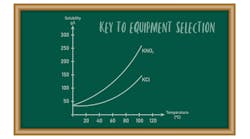The most common question I get when developing a new process that involves solids is: “Should it be batch or continuous?” The standard answer always is: “It depends.” And, sometimes, the right answer is “neither” — because you may be better off to use batch on front-end operations followed by a continuous process; solids are not simple one-phase systems.
Of course, economics ultimately determine the choice. How long do you expect this product to last in the marketplace? How much capital are you willing to risk? Product development generally takes place in batch operations. So for scale-up, because of the many factors that come to play with solids processing, I usually suggest first going to a 10× batch operation before considering an expansion to continuous. Then, when evaluating what type of operation to use for large-scale production, look at the following factors:
• Market. We often think that a high production rate calls for a continuous process. Large-scale continuous production certainly boasts economic advantages. However, a continuous operation may limit your flexibility in altering the product to respond to market demands. So, you always should consider the “what ifs.” For instance, if you anticipate the eventual need to change particle size, doing so can be difficult in a continuous process, especially if the new size results in a lower production rate. To avoid this unpleasant surprise, challenge your marketing people to investigate how long the market will last and what competitive products may crop up in the near future that may reduce the product’s lifetime.
• Existing equipment. Ask about what assets you already own that will work on this product and whether a plant could integrate the product into its current operations. This can be a Catch-22 with most crystallizers or dryers originally designed for a specific product. You must resolve issues concerning suspension of the solids on the new product, heat transfer and encrustation. My experience with using existing equipment hasn’t been good. The operators seldom are alerted to the differences between the new product and what they have been making for years. While not a safety issue, processing may involve subtle changes in flowability or temperature sensitivity.
• Complexity. Batch operations may be good when many steps are involved and the same type of equipment could handle multiple steps — for example, a repeated sequence of crystallization, followed by a filtration, then a reaction and another crystallization. While common in pharmaceutical operations, those steps can raise questions of contamination or the extra cost of cleaning the equipment.
• Potential for change to the model. Batch operations allow for alterations that may occur in the process. The model developed from research could have missed some heat-transfer issues or mixing problems that didn’t show up on a small scale. If you have these concerns, I suggest further batch scale-ups before looking at a continuous process.
• Expansion potential. If you have to boost production, adding another solids processing device is a quick but expensive solution for batch systems. In contrast, upping the output in a continuous process may be as simple as adding a new pump or increasing the temperature. Work with the research or development team to assess how to expand operations in the most cost-effective manner.
• Regulations. Often, compliance with government regulations, such as those of the U.S. Food and Drug Administration or Environmental Protection Agency, favors batch operations. They may allow you to limit losses from a bad batch or give you an opportunity to recoup your costs by selling that batch to a secondary market. On the other hand, documenting compliance is easier and less costly with continuous operations. Also, the evolution of online instrumentation into a reliable part of chemical operations favors a continuous process.
One additional item to consider when choosing between batch and continuous is that we are working with particulate solids. My company participated in a study of the outcomes of projects for the production of chemicals. While a few projects involving gases and liquids failed to meet on-time delivery or expected project cost, projects involving solids generally failed to achieve expectations. Two never started up. With solids, plan on extra time and costs, especially if it is a continuous process. So, unfortunately, the answer to the original question still is “It depends.”



